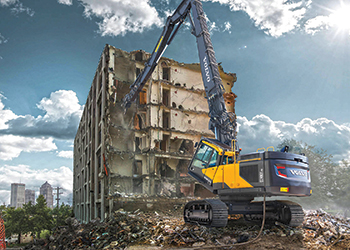 Volvo EC480EHR ... precision demolition at work.
Volvo EC480EHR ... precision demolition at work.
Volvo Construction Equipment’s latest demolition machine, the Volvo EC480EHR high-reach excavator, demonstrated its prowess recently – and created a stir – when tasked to take on one of the largest demolition jobs in the Netherlands.
Residents of the small Dutch town of Zwolle gazed upwards in amazement as the long, steel neck of a monstrous Volvo EC480EHR chomped away at the masonry of what was once part of Weezenlanden Hospital.
“This is precision demolition,” observes Erik Zwerver, commercial manager of Boverhoff, one of the largest demolition companies in the country. “Everyone thinks demolition is dirty and rough, but it’s like building backward – you have to be very precise.”
Indeed, a project of this scale requires the utmost precision, carried out by a skilled operator. Aalt Witman laughs as he describes the day he operated the Volvo EC480EHR high-reach excavator for the first time.
“It was a real challenge,” he says. “The first time you look up into the clouds is awe-inspiring. You get a real flutter in your stomach – it gives you such a kick.”
The Dutchman might have 23 years of experience as an operator, but the boom he is more familiar with is just 11 m long, not 28 m like this one. Yet, after just a couple of days in the cab, Witman was confidently tearing down the 1960s building.
In place of the crumbling hospital, nearly 300 new homes will be built, making this demolition project not only one of the biggest in the Netherlands, but also the first to use Volvo CE’s new E-Series ultra-high-reach excavator.
According to Zwerver, the Volvo EC480EHR’s specifications make it ideal for this type of project. The height of the machine enables it to dismantle the hospital buildings brick by brick.
Inside the Volvo cab, Witman particularly likes the high visibility, as well as the extra cameras. The 30-degree tilt of the cab makes looking upwards more comfortable, and the on-board eight-inch monitor enables good communication between machine and operator. Another great feature, says Zwerver, is the total moment indicator, which flashes a warning if the machine is in danger of destabilising.
For the contractor, the key selling features of the EC480EHR were not just the towering height and heavy tool weight (3.5 tonnes), but also the fact that the machine was purpose-built by Volvo CE for ease of transport. The new electro-hydraulic system, with retractable undercarriage and hydraulically removable counterweight, contribute to easy road transportation, features of particular value to the company, which often operates in urban areas.
Because of the close proximity of the hospital to the town centre and the local community, the demolition work was to be carried out with minimal dust, noise and vibrations.
Above all, it’s the performance of the Volvo EC480EHR high-reach excavator that is most notable to the demolition contractor. The company owns more than 20 crawler excavators in the 30-tonne class and higher, with more than half comprising of Volvo machines, including wheel loaders and excavators.
The EC480EHR high-reach demolition equipment from Volvo is equipped with the latest innovations to increase productivity. A robust structure, heavy tool weight and outstanding hydraulics ensure a strong performance in even the toughest of demolition projects.
The high-reach excavators are built to ensure maximum safety in all demolition applications. A sturdy frame and cab offer ultimate protection against the falling debris, and a wide, clear view of the jobsite provides excellent visibility for enhanced safety. The high-visibility cab – designed specifically for high-reach demolition – ensures higher productivity and carefully placed cameras ensure operators have a clear view of the jobsite at all times, for the ultimate safe, productive working environment.
A frame-mounted falling object guard protects the operator and cab from falling debris, enhancing safety and machine uptime.
For better productivity, the machine’s structure and hydraulic system have been optimised to carry heavier attachments. The maximum pin height has been increased to widen the operator’s working range and maximise productivity.








.jpg)




.jpg)




























.jpg)
































